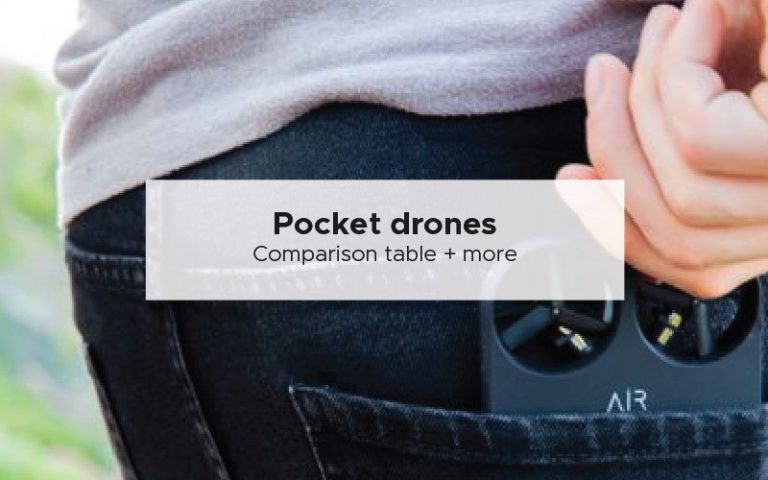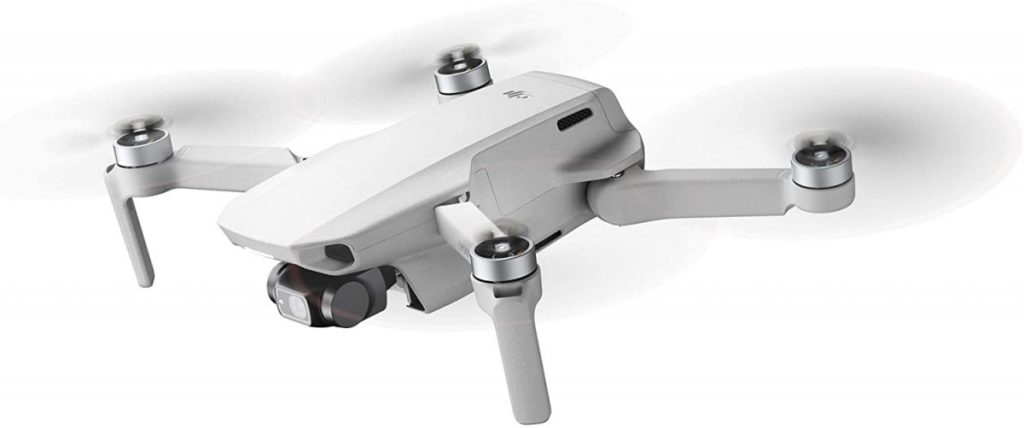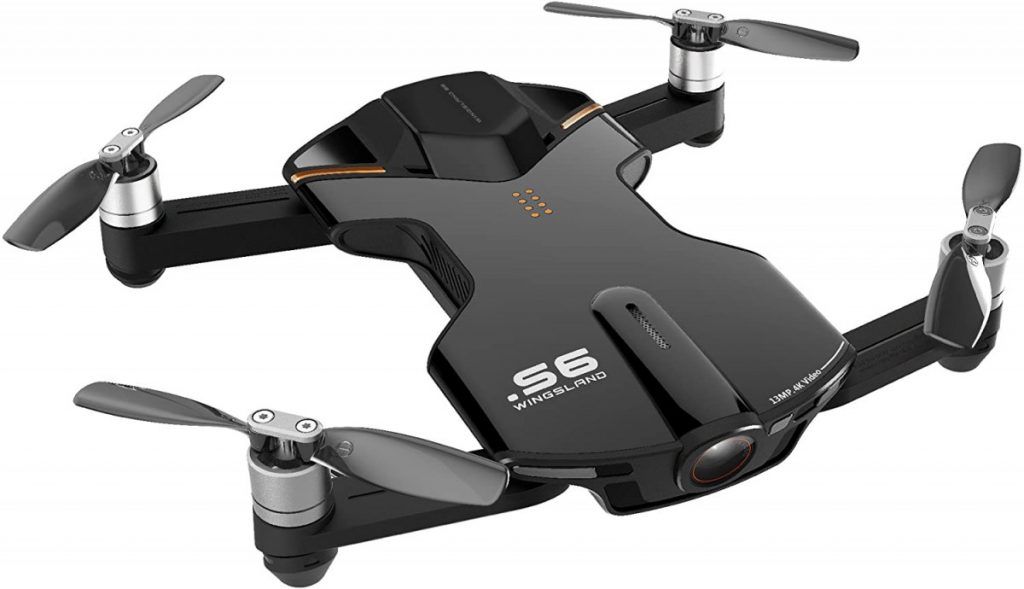Pocket drones are a fantastic type of drone for people who want to take their drones everywhere with them. You may not be putting them in your pocket but their size allows them to be taken anywhere and easily squeezed into an everyday carry bag. They are light, rugged, and have a camera that allows you to take selfies quickly. The pocket drones reviewed in this article may not have the longest flight time but capturing those quick shots has never been easier.
Pocket drones must fit in an average pocket with a length of 231 mm and a width of 163 mm. They allow you to take your drone anywhere, quickly capture selfie’s and other shots without laborious setup, and are perfect for travellers and influencers.
Since 2016 there has been a load of different companies which developed drones that can fit in a pocket. People want a drone to fit in a pocket so that they can take it anywhere and is as convenient and accessible as a smartphone. In this article, we will go over all of the latest drones which can fit in your pocket and also talk about why they aren’t as common as they used to be.
What is a pocket drone?
A pocket drone is a drone that fits in the average pocket with a depth of 231 mm and a width of 163 mm. There was a huge demand in the early days of drones to push drone sizes are smaller and smaller so that they could be taken absolutely anywhere – on any adventure – in order to capture selfie’s and other aerial shots.
These drones can also be called selfie drones because they provide a very quick and convenient way of capturing the perfect selfie and getting a unique aerial viewpoint of their subjects.
What is a selfie drone?
A selfie drone is simply a drone has been optimised for taking selfie is to post on social media. They are typically small, have a short battery life, and are rugged enough to carry with you every day.
They are optimised for taking photographs of people indoors or outdoors, and have a very short flight time because they do not need to go very far away from the drone operator. Selfie drones are typically controlled by a smart phone app which means that you do not need a dedicated remote control which can save on space while carrying the drone.
I think that we can use selfie drone and pocket drone interchangeably as they seem to occupy the same market segment and customer base. Let’s have a look at the benefits of pocket drones and some of the drawbacks that you need to consider if you think you are in the market for a pocket drone.
The benefits of pocket drones
There is no doubt that having a small drone means that you are more likely to take it places with you. I know that with my DJI Mavic air I have been much more likely to take it places because of the size that it packs down to. It is just not able to fit in my pocket comfortably, however.
Here are the benefits that a pocket drone has over other much larger drones.
Small size
The most obvious thing is the size. When I was initially in the market for a drone I wanted a drone I could take with me everywhere – in a bag. Some of today’s more expensive consumer drones are relatively heavy and the extra batteries you carry add to the weight.
Believe it or not, when I am heading out the door I often think to myself: “I should take my drone”. However, a lot of the time I leave it behind only to regret my decision much later. With a pocket drone you can carry with you pretty much all the time – like a smart phone – so that it is a gadget that is on hand when you really needed. Most importantly, when you didn’t know you would need.
Rugged
because these pocket drones are relatively small the manufacturers typically engineered the drone so that it is able to be carried in pockets and bags. That means they have thought about things like:
- Protecting the propellers – quite often pocket drones have propeller guards which enable you to have extra confidence when checking them in your bag.
- Solid body – many of the pocket drones have a solid body and not arms that unfold because it means that they are harder to break.
- Lightweight – because of their size and battery limitations pocket drones are relatively light weight. This means that if you were to drop them they are very unlikely to break completely. Their light weight allows them to crash land without issue.
All of these things means that you’ll be super competent take your drone out with you in your pocket or bag.
Unique selfies
The great thing about pocket drones is that you are able to capture photos of your friendship group, or yourself, which you are unable to do with regular smartphone cameras or the longest of selfie sticks.
I like to think of a pocket drone as the ultimate camera and tripod combination. It allows you to camera in the sky without having to carry relatively cumbersome tripods or extra equipment to secure your camera to a fence or post.
Because pocket drones have very limited use cases they clearly have some downsides. Let’s explore these, below.
The cons of pocket drones
There is no doubt that when you try to squeeze something into your pocket that there is going to be a play-off between features and size. Here are some of the unfortunate compromises that need to be made if you are trying to squeeze a drone with any significant flight time into your pocket.
Short flight times
Unfortunately, pocket drones suffer from incredibly short flight times on average. That is because if you want something to fit in your pocket you are limited to the physical size of the battery and therefore the battery’s capacity is going to be severely limited.
However, there are some small drones (that are on the border of being pocket size) which allow you to fly for up to 30 minutes.
These drones include DJI Mavic mini and the DJI Mavic mini 2. These drones are much more expensive but they give you much more capability when in the air and have incredible flight times for such small drones.
Limited number of applications
Lastly, pocket drones are severely limited by how far away they can fly from the operator if they do not have a remote control. Some of the drones in this article only have a maximum controllable distance of 100 m and a short flight time of about 10 minutes. This means that you have significantly limited applications for the drone.
That said, the DJI drones in this article are on the border of selfie drones and more serious drones. They are able to do much more than some of the dedicated pocket drones because of the technology and advanced hardware which has been developed by DJI.
If you are regularly flying in extreme conditions or high winds I would recommend that you do not fly your pocket drone and by a drone which is much more capable.
If, however, you want to take awesome selfies and have the option of controlling it with your smart phones that you do not have to deal with any pesky communication issues between the drone and the remote controller a pocket drone will allow you to do exactly that. Buying the right tool for the right jobs means that a pocket drone may be all you need to fulfil everything you want to do with a drone.
How much is a pocket drone?
Best pocket drones on the market:
Comparison table:
| Size (mm) | |||||||
| Weight (g) | L | W | H | Camera | Flight time (min) | Link video review | |
| Wingsland S6 | 230 | 177 | 102 | 51 | 4K | 10 | YouTube |
| DJI Mini 2 | 249 | 138 | 81 | 58 | 4K | 31 | YouTube |
| DJI Mini | 249 | 140 | 81 | 57 | 1080p | 30 | Youtube |
| Hover Camera Passport | 242 | 182 | 132 | 33 | 4K | 10 | YouTube |
| Air PIX | 52 | 102 | 85 | 0.51 | 1080p | 6 | YouTube |
| Average pocket size | 231 | 163 |
Wingsland S6
This drone is truly a pocket sized drone. It is one of the thinnest 4K drones in the world and at only 230 g and the size of an iPhone it easily fits inside your pocket so you can take it anywhere with you.
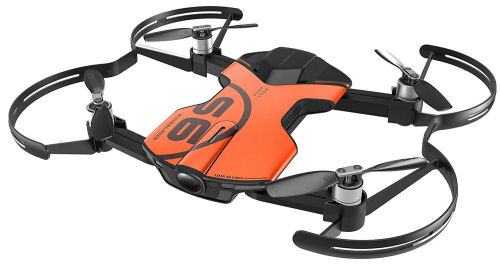
It can fly at a maximum altitude of 100 m and a distance of 100 m away from the drone pilot. It has a number of flight modes including beginner mode, standard mode, home lock mode, and calls lock. This means that you will be able to find a flight mode for every level of ability. With intelligent functions like one button takeoff and auto landing, return to home, point of interest (whether aircraft orbits object automatically), 360° photo and also flipping – this is a drone which can be utilised in a variety of different ways.
The issue this drone is very small battery which is approximately 10 minutes depending on environmental conditions and how aggressively you fly drone.
You can also attach a searchlight, a mini toy gun, and emotive display screen and object avoidance attachment if you are looking for those extra little things which can make a huge difference to much fun this pocket drone is to fly.
DJI Mini 2
The DJI mini 2 is an ultra lightweight and foldable pocket drone. It weighs less than 250 g is a maximum flight time of 31 minutes. This drone is backed up by DJI’s incredible 10 km video transmission and this drone is able to be flown eight doors with confidence as it has a level V wind resistance.
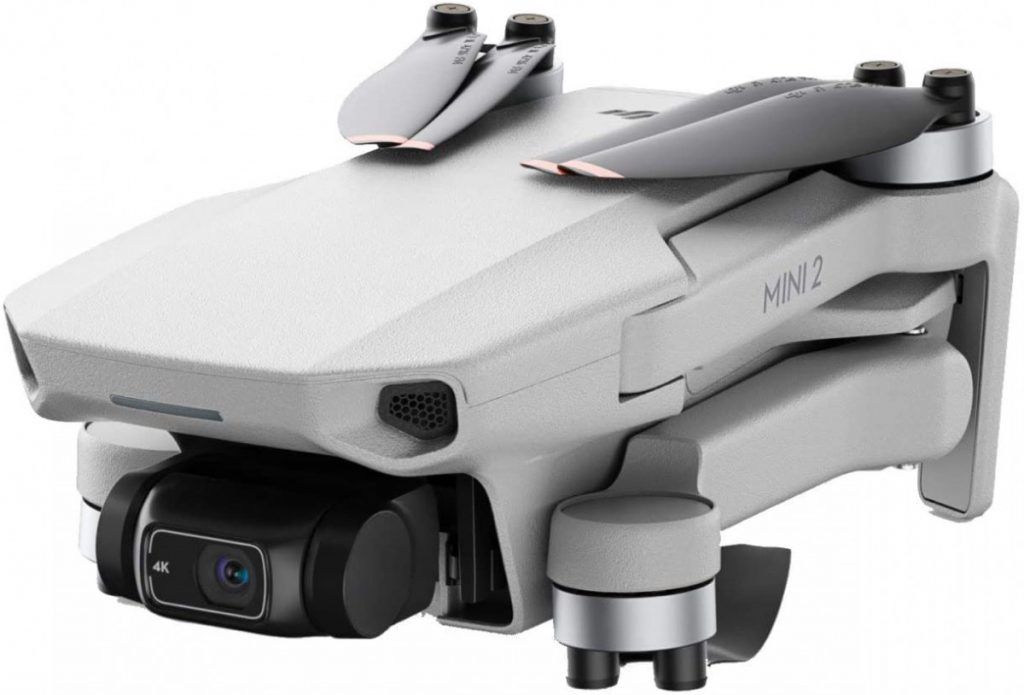
It has a number of intelligent flight modes and quick shots which means that you are able to capture images quickly.
Even though this drone is small do not be tricked into thinking that it is not powerful. The DJI mini 2 provide you with freedom whether you are shooting at a deserted beach or capturing details of a fun family and friends get together in your back garden.
The OcuSync 2.0 video transmission means that you have got up to 10 km of high definition first person view range. In reality the battery will run out well before you get 10 km away.
With a 4K camera and four times zoom this drone improves on the DJI Mavic mini in terms of both resolution and ability – DJI Mavic mini no capability for zoom.
With a range of accessories including a charging base, propeller guard, and a two-way charging hub this drone can also look also while you are charging at home.
You may not want to stick this drone in your pocket as the propellers will easily get bent or damaged as they are not secured to the drone. Also, it has foldable arms which could get caught on your pocket as your sliding. However, for a mini drone which has the feature set of the much larger drones you should check this one out!
DJI Mavic mini
The DJI Mavic mini was one of the first pocket drones that have serious capabilities. It was quickly superseded by the DJI Mavic mini 2, above. But, if your budget is a little bit lower this drone is certainly something that you shouldn’t ignore.
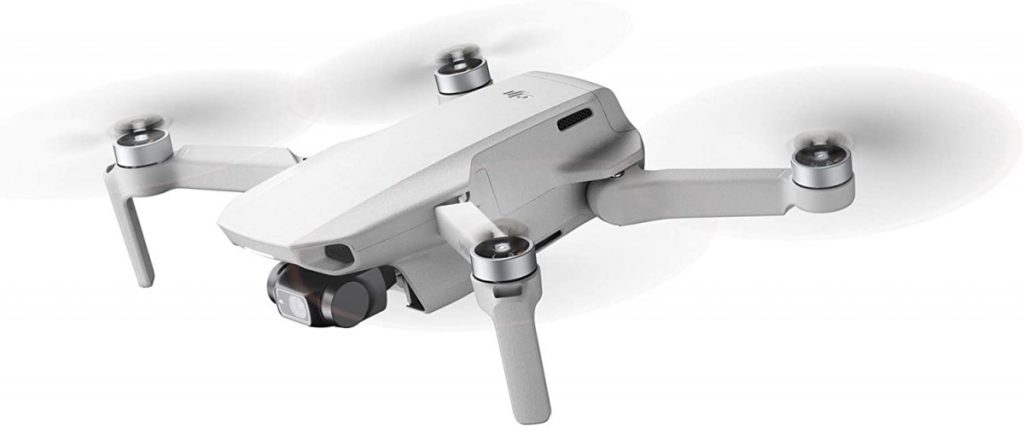
It is 249 g and has a maximum flight time approximately 30 minutes. It has 4 km high-definition video transmission which is a little bit lower than the DJI Mavic mini 2 but more than enough for the average user stop it has a 2.7 K camera which allows you to record footage suitable for the majority of use cases such as YouTube and high-definition videos.
Weighing in at only 250 g is almost as light as a smart phone which means that you do not need to have a pilots license to fly in America. You are easily able to fly the drone inside as propeller guard fully protects the propellers so you can fly safely around your house.
It comes fully packed with the automatic shots such as dronies, rocket shots, circles, and helix that DJI drone users have become familiar with as part of their app.
Even though this drone is relatively old it still has many features that people looking for a pocket drone will love.
Hover Camera Passport
The hover camera passport is a drone which has self flying abilities and packs down into a foldable powerful and portable package.
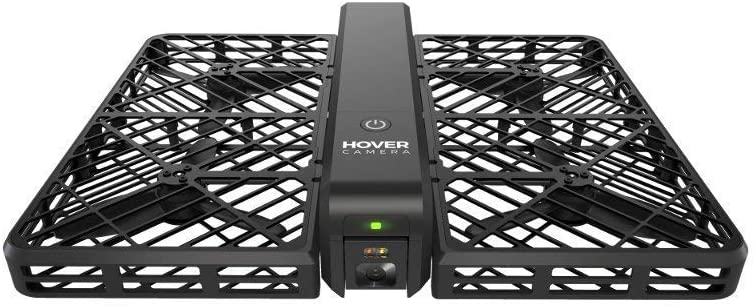
Once unfolded the drone is able to completely fly on its own and by using face detection technology is able to follow you when you are surrounded by a range of people. The hover camera folder into an incredibly small size which makes it perfect for capturing your moments wherever you are stop you can film yourself autonomously because the hover camera or circle around you and it will also capture 360° panoramic video with you at the centre.
At only 242 g you don’t have to register it in some regions and the drone blades are completely surrounded by guards which means that you are able to grab it easily while it is Medicare but also is able to be transported quickly and easily without having to put it in another bag or case for protection.
While it is flying around you are also able to use gesture control to snap photos using hand gestures which makes it a breeze for those moments where you just want to quickly send up your drone and capture footage without mucking around with controls.
Air PIX
Air pix is the pocket sized and ultralight aerial camera which you can preorder on their website stop it has a 12 megapixel photo capability and can record high definition 1080p videos. It has 8 GB of on-board memory and with simple app and gesture control it is the perfect drone for taking photos and videos of yourself.
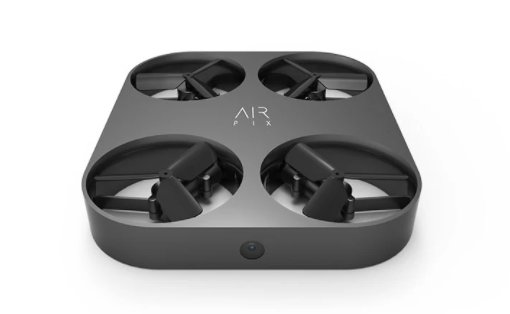
Air pix is able to fly and shoot selfies without a smart phone connection the artificial intelligence will find you and shoot selfies and fly back to you without using the app.
The propellers are housed within the reinforced and lightweight plastic chassis which means that you don’t have to be worried about getting chopped up by the propellers. It is ultra lightweight at 52 g which means that it is much lighter than the smart phone is currently in your pocket.
The flight time is very short but it has an optional power backed docking sleeve which means that your Air pix can be fully charged and ready to shoot at all times.
The air pix drone slips into the dock and the dock slipped into your pocket with ease.
Because this is a new company with a new product there are a load of issues that they need to sort out before you consider buying this. There are a load of software issues and hardware issues that need to be addressed before you are able to fly this confidently and without any issues. Check out the reviews online before purchasing to see if it is a risk worth taking for you.
Size comparison of pocket drones
It can be hard to work out what size each of the drones in this list are. So I have done a size comparison chart of all of the pocket drones which can be seen in the image below.
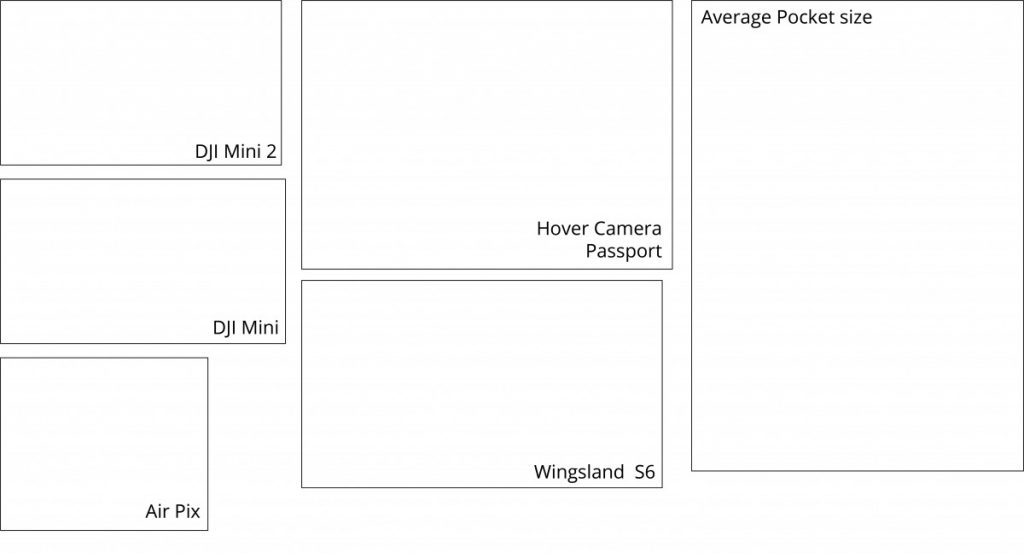
I have included a typical pocket size which can be used to determine whether or not the drone is able to fit into a regular pocket.
Pocket drones buyers guide:
Here is a buyers guide to pocket drones and all of the important things that you need to consider before parting with your hard earned money.
Folded size
Clearly, if you want a pocket drone the folded size is an important metric to consider before buying a pocket drone.
The fact is that there are not many pocket drones on the market because it is a very niche application. I think we have gone past the peak selfie times and therefore people are looking for more serious applications and drones to take photos.
Nonetheless no matter what the application you want your drone for the folded size is going to be an important factor in determining how often you take your drone out and about with you.
I absolutely love my DJI Mavic air as it is small enough to chuck in my bag when I’m heading out the door and it is also able to fly in some strong winds and capture some amazing footage with no issues.
If you are looking for a pocket drone make sure that you choose a drone which is able to be folded down into the size limits that you have in your pocket or bag.
Flight time
in fortunate thing about pocket drones is that they are very light and small which means that the battery is severely limited in size. The smallest drones in this article have only got a flight time of between six and 10 minutes under ideal conditions.
The much bigger drones in this list such as the DJI Mavic mini and the DJI Mavic mini 2 have a flight time of up to 30 minutes but they are much deeper and although they will fit in a pocket they are probably not strictly pocket drones.
You have a couple of options if you are going through drone with severely limited flight time. You can firstly buy extra batteries for your drone which will enable you to swap out the batteries to double your flight time.
Secondly, some drones are able to be charged at relatively quickly – because they have small batteries – which means that you are either able to charge them with a supply charger or you can use the portable charger as in the Air pix example.
Protection for travel
If you are considering buying a pocket drone you may want to consider if it comes with a carry case or a form of protection for travelling.
If the drone has protected propellers and a hard body that does not include foldable arms is not likely that you will need to protect the drone with a case. If, on the other hand, your drone has foldable arms and propellers which are not secured in place when packed down you will need to consider purchasing a soft or hard carrying case which will extend the lifetime of your drone.
Controls
Pocket drones can be controlled either through a smart phone app or directly with gesture controls. In my experience, gesture controls even on the higher end drones are not always reliable. I would recommend getting a drone that has a smart phone app that you can use to control the drone and the camera rather than relying on the camera for gesture control.
Headless mode
Headless mode is when the drone moves in the direction that the joystick is moved in irrespective of the orientation of the drone.
Headless mode is a great way for kids and inexperience flyers to get the best flying experience possible.
Flying toward yourself can be problematic as the left and right controls on the joystick have been swapped which means that it can be harder to fly your drone toward yourself.
Get headless mode if you’re drone is for a younger or less experienced pilot.
Sensors
Buying a drone that has very limited space in the body means that you can’t often buy a pocket drone with good sensors. However, if you can afford it I recommend splashing out for a drone which have a number of sensors to help it to avoid obstacles.
Obstacle avoidance is something that has saved my drone from a collision and crash many times. Typically drones will have forward, outwards and downwards facing sensors which measure the distance of the drone from some obstacles.
In some models of drone the drone will stop at about 3 m away from the obstacle. In other, more advanced drones, the drone will be able to actively avoid the obstacle and fly around it. This is becoming more and more common in the latest model of drones.
Who is a pocket drone for?
Although there are a range of drawbacks for purchasing a pocket drone here are some of the use cases which I think would be perfect for buying a drone that is small, portable, lightweight, and inexpensive.
Travelers
People who are travelling and have limited luggage space and weight restrictions could use a pocket drone to capture their adventures whilst keeping the extra weight they carry low.
If you only want to capture shots that would typically be taken by a selfie stick you can get away with some of the cheaper drones in this article such as the wingsland S6 and the hover camera passport.
However, I would recommend that if you are serious about capturing your travels you invest in the DJI Mavic mini 2 as it will do a much better job at capturing your adventures whilst also giving you the flexibility to fly outdoors and much further away from the drone pilot.
Influencers
Selfie’s seem to be the land of the influencer. If you want to capture some quick and easy unique shots of you for your social media channel grabbing yourself a pocket drone is the easiest way to do that.
People are always looking for unique shots to stand out online and a pocket drone opens up a whole new world of photography and selfies which are not achievable by any other means.
People who want indoor shots
I have tried to fly my DJI Mavic air indoors a number of times. The one thing that stands out about the drone when it is flying indoors is the noise it makes. It is incredibly loud.
The smaller the drone and the less powerful the brushless motors the less noise the drone will make. This means that when it is flying indoors it will not be a horrible experience for the people having their photograph taken.
There is nothing worse than seeing people uncomfortable in an indoor drone selfie through either the noise or the fact that they are not sure whether or not the drone is just simply going to smash into them.
Buying a pocket drone which is easy to send up into an indoor space and isn’t causing a scene may be a great option if that is why you are purchasing a drone.
Summary
In this article, we have gone over all of the true pocket drones which are available on the market. These types of drones are becoming fewer and fewer because people want to be able to do more with their drone then just take selfies and fly indoors.
However, there are some use cases for pocket drones which means that there will always be a company looking to revolutionise and miniaturise drone technology to make it easy for people to capture selfies and other hard to get shots.
Happy drone flying and good luck finding the best pocket drone for you!
